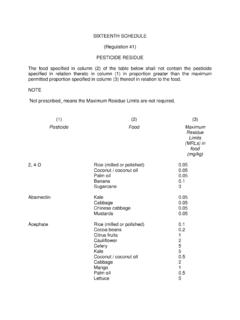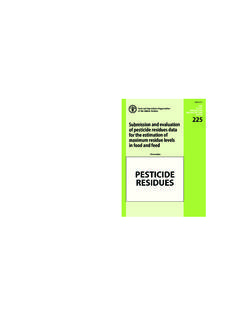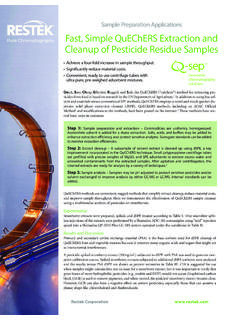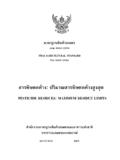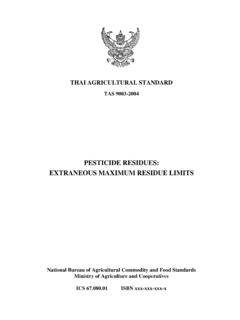Transcription of JOINT FAO/WHO MEETING ON PESTICIDE RESIDUES
1 Summary Report from the 2010 JOINT FAO/WHO MEETING on PESTICIDE RESIDUES (JMPR) 1 Food and Agriculture Organization of the United Nations World Health Organization JOINT FAO/WHO MEETING ON PESTICIDE RESIDUES Rome, 21-30 September 2010 SUMMARY REPORT ACCEPTABLE DAILY INTAKES, ACUTE REFERENCE DOSES, SHORT-TERM AND LONG-TERM DIETARY INTAKES, RECOMMENDED MAXIMUM RESIDUE LIMITS AND SUPERVISED TRIALS MEDIAN RESIDUE VALUES RECORDED BY THE 2010 MEETING Issued October 2010 The following extracts of the results of the annual JOINT FAO/WHO MEETING on PESTICIDE RESIDUES (JMPR)
2 Are provided to make them accessible to interested parties at an early date. The MEETING evaluated 23 pesticides , of which 8 were new compounds, and 5 were re-evaluated within the periodic review programme of the Codex Committee on PESTICIDE RESIDUES (CCPR). The MEETING established acceptable daily intakes (ADIs) and acute reference doses (ARfDs). The MEETING estimated maximum residue levels, which it recommended for use as maximum residue limits (MRLs) by the CCPR. It also estimated supervised trials median residue (STMR) and highest residue (HR) levels as a basis for estimation of the dietary intake of RESIDUES of the pesticides reviewed.
3 Application of HR levels is explained in Chapter 7 ( ) of the FAO Manual on the submission and evaluation of PESTICIDE residue data for the estimation of MRLs in food and feed (2009). The allocations and estimates are shown in the table. pesticides for which the estimated dietary intakes might, on the basis of the available information, exceed their ADIs are marked with footnotes, as explained in detail in the report of the 1999 MEETING (section ). Footnotes are also applied to specific commodities when the available information indicated that the ARfD of a PESTICIDE might be exceeded when the commodity was consumed.
4 It should be noted that these distinctions apply only to new compounds and those re-evaluated within the CCPR periodic review programme. The table includes the Codex reference numbers of the compounds and the Codex classification numbers (CCNs) of the commodities, to facilitate reference to the Codex maximum limits for PESTICIDE RESIDUES (Codex Alimentarius, Vol. 2B) and other documents and working documents of the Codex Alimentarius Commission. Both compounds and commodities are listed in alphabetical order.
5 Summary Report from the 2010 JOINT FAO/WHO MEETING on PESTICIDE RESIDUES (JMPR) 2 Apart from the abbreviations indicated above, the following qualifications are used in the Table. * (following name of PESTICIDE ) New compound ** (following name of PESTICIDE ) Compound reviewed within CCPR periodic review programme * (following recommended MRL) At or about the limit of quantification HR-P Highest residue in a processed commodity, in mg/kg, calculated by multiplying the HR in the raw commodity by the processing factor Po The recommendation accommodates post-harvest treatment of the commodity.
6 PoP (following recommendation for processed foods (classes D and E in the Codex classification) The recommendation accommodates post-harvest treatment of the primary food commodity. STMR-P An STMR for a processed commodity calculated by applying the concentration or reduction factor for the process to the STMR calculated for the raw agricultural commodity. W (in place of a recommended MRL) The previous recommendation is withdrawn, or withdrawal of the recommended MRL or existing Codex or draft MRL is recommended.)
7 More information on the work of the JOINT FAO/WHO MEETING on PESTICIDE RESIDUES (JMPR) is available at: Summary Report from the 2010 JOINT FAO/WHO MEETING on PESTICIDE RESIDUES (JMPR) 3 Established ADI and ARfD values and recommended MRL, STMR and HR values PESTICIDE (Codex reference number) CCN Commodity Recommended MRL mg/kg New Previous STMR or STMR-P mg/kg HR or HR-P mg/kg Bifenazate (219) VD 0071 Beans (dry) ADI: 0 mg/kg bw FB 0264 Blackberries 7 FB 0266 Dewberries (including Boysenberry and Loganberry) 7 FB 0272 Raspberries 7 ARfD: Unnecessary VP 0060 Legume vegetables 7 Definition of the residue (for compliance with the MRL for plant and animal commodities and for estimation of dietary intake for plant and animal commodities): Sum of bifenazate and bifenazatediazene (diazenecarboxylic acid, 2-(4-methoxy-[1,1'-biphenyl-3-yl] 1-methylethyl ester), expressed as bifenazate.)
8 The residue is fat-soluble. Bifenthrin (178)** FI 0327 Banana ADI: 0 mg/kg bw GC 0640 Barley W * ARfD: mg/kg bw AS 0640 Barley straw and fodder, dry W FB 0264 Blackberries 1 VB 0040 Brassica (cole or cabbage) vegetables, Head cabbages, Flowerhead brassicas MF 0812 Cattle fat W MO 1280 Cattle kidney W a * MO 1281 Cattle liver W a * MM 0812 Cattle meat W a (fat) ML 0812 Cattle milk W a * PE 0840 Chicken eggs W * PF 0840 Chicken fat W * PM 0840 Chicken meat W * (fat) PO 0840 Chicken, Edible offal of W * FC 0001 Citrus fruits SO 0691 Cotton seed AB 1203 Cotton seed meal OR 0691 Cotton seed oil, edible FB 0266 Dewberries (including Boysenberry and Loganberry) 1 MO 0105 Edible offal (Mammalian)
9 VO 0440 Egg plant FC 0203 Grapefruit W b * DH 1100 Hops, dry 20 10 Beer FC 0204 Lemon W b * GC 0645 Maize * * 0 AS 0645 Maize fodder 15 dw dw OC 0645 Maize oil, crude 0 OR 0645 Maize oil, edible 0 CF 1255 Maize flour 0 Maize grits 0 Maize starch 0 FI 0345 Mango c MM 0095 Meat (from mammals other than marine mammals) 3 (fat) fat muscle fat Summary Report from the 2010 JOINT FAO/WHO MEETING on PESTICIDE RESIDUES (JMPR) 4 PESTICIDE (Codex reference number) CCN Commodity Recommended MRL mg/kg New Previous STMR or STMR-P mg/kg HR or HR-P mg/kg muscle FM 0183 Milk fats 3 ML 0106 Milks VL 0485 Mustard greens 4 VO 0442 Okra FC 0208 Orange, sweet W b * FI 0350 Papaya c AL 0072 Pea hay or Pea fodder (dry) dw dw FP 0230 Pear W VO 0051 Peppers HS 0444 Peppers, chili (dried) 5 VR 0589 Potato W d * VD 0070 Pulses VL 0494 Radish leaves (including Radish tops)
10 4 SO 0495 Rape seed OR 0495 Rape seed oil, edible Rape seed meal FB 0272 Raspberries, Red, Black 1 VR 0075 Root and tuber vegetables AB 1265 Soya bean meal OR 0541 Soya bean oil, refined FB 0275 Strawberry e 3 1 DT 1114 Tea, Green, Black (black, fermented and dried) 30 VO 0448 Tomato VW 0448 Tomato paste Tomato puree TN 0085 Tree nuts GC 0654 Wheat Po Po CM 0654 Wheat bran, unprocessed 2 PoP 2 PoP PoP PoP CF 1211 Wheat flour W f PoP CF 1210 Wheat germ 1 Po PoP PoP AS 0654 Wheat straw and fodder, dry W CF 1212 Wheat wholemeal W f PoP Definition of the residue (for compliance with the MRL for plant and animal commodities and for estimation of dietary intake for plant and animal commodities): bifenthrin (sum of isomers).










